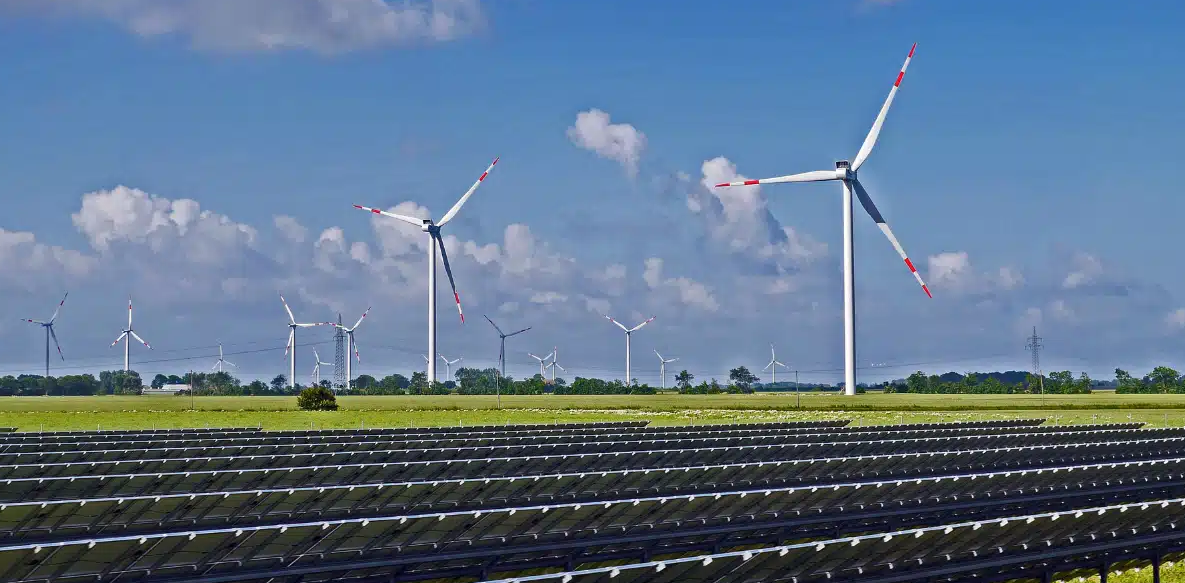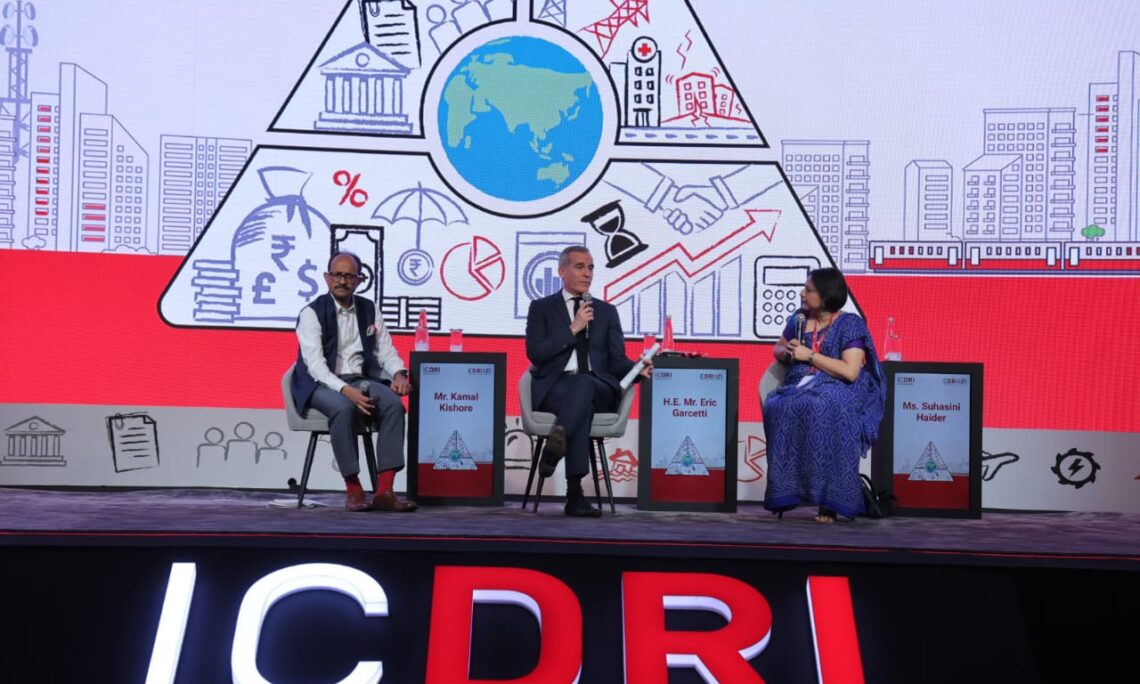
Renewable energy developments in India reached historic levels when the country added 25 GW of new capacity during the financial year 2024-25 while showing a 35% increase over last year. Major advancements happened in renewable energy establishment through solar power while domestic solar manufacturing growth along with green hydrogen production and solar pump setup under essential government initiatives delivered notable achievements.
Key Points:
-
Record Renewable Energy Addition:
-
25 GW of renewable energy capacity additions during FY 2024-25 represented a 35% increase from the previous year’s total of 18.57 GW.
-
-
Solar Sector Growth:
-
The solar sector observed substantial development between FY24 and FY25 when its capacity additions reached 21 GW from 15 GW resulting in a 38% growth.
-
The total solar power capacity installed in India has reached above 100 GW.
-
-
Domestic Solar Manufacturing Expansion:
-
The manufacturing output of solar modules reached 74 GW during March 2025 while March 2024 demonstrated only 38 GW of capacity.
-
The manufacturing capacity of solar PV cells increased by 300% because it rose from 9 GW to 25 GW.
-
The first Indian company manufacturing ingot-wafers (2 GW capacity) started operations.
-
The ₹41,000 crore investments through the PLI scheme employed 11,650 individuals.
-
-
PM Surya Ghar Muft Bijli Yojana Impact:
-
Over 11.01 lakh households benefited.
-
The Government distributed ₹5,437.20 crore as Central Financial Assistance to 6.98 lakh beneficiaries.
-
-
Advancements in Green Hydrogen Sector:
-
The electrochemical company manufacturing sector received ₹2,220 crore incentives to produce 1,500 MW per annum of electrolyzers.
-
The government allocated ₹2,239 crore for developing production capacity of 4,50,000 TPA Green Hydrogen.
-
The seven pilot projects in the steel sector will receive ₹454 crore from central funds.
-
The government invested ₹208 crore for implementing five pilot programs that would fuel transportation with hydrogen.
-
-
PM-KUSUM Scheme Achievements:
-
The implementation of solar pumps has reached 4.4 lakhs even though FY24 had just 4.2 thousand solar pumps initially (4.2-fold increase from FY24).
-
The number of pumps with solar power doubled to reach 2.6 lakh throughout the year (25 times above the FY24 total).
-
The overall number of solar pumps installed and solarized exceeds 10 lakh units.
-
The financial outlay of the PM-KUSUM program grew to ₹2,680 crore as it demonstrated a 268 percent increase during the same period the previous year.
-
-
IREDA's Role in Renewable Energy Financing:
-
The financial institution provided 27% more loans totaling ₹47,453 crore in the given period.
-
Lending institutions distributed 20 percent more funds which totaled up to ₹30,168 crore during the period.
-
What is Renewable Energy?
-
The adopted strategy of renewable energy production utilizes natural sources to deliver power at rates that exceed its consumption rate thus sustaining the environment.
-
India maintains its status as a worldwide leader in renewable energy through determined target settings and substantiated infrastructure deployment combined with purposeful policy development.
-
India has established multiple schemes in addition to its 2030 target of producing 500 GW renewable energy through various implementation actions.
Sources of Renewable Energy:
-
Solar Energy: Converts sunlight into electricity via photovoltaic panels or concentrated solar power. The solar energy resources available in India amount to approximately 748 GW.
-
Wind Energy: Wind turbines operating from both onshore and offshore sites enable the generation of electricity from moving air according to wind energy principles.
-
Hydro Energy: Hydropower Energy obtains power by enabling water movement between elevated and lowered positions through reservoirs and rivers.
-
Bioenergy: Derived from organic materials such as wood, charcoal, manure, and agricultural crops for power production.
Renewable Energy Policies and Schemes:
-
The government aims to decrease carbon intensity levels by 45% throughout 2030 while making a commitment to become carbon emission neutral in 2070.
-
Foreign Direct Investment (FDI): The policy encourages Foreign Direct Investment (FDI) by allowing 100% entry through automatic route to draw investments from international sources.
-
National Green Hydrogen Mission targets a production of 5 million tonnes of green hydrogen by 2030 while receiving a total budget of INR 19,744 Cr.
-
PM-KUSUM: Through PM-KUSUM the government promotes solar irrigation pumps to enhance farmer income and decrease diesel consumption for irrigation purposes.
-
PM-Surya Ghar Muft Bijli Yojana: Encourages residential solar rooftop adoption with a 60% subsidy for systems up to 2 kW.
Significance of Renewable Energy:
-
Climate Change Mitigation: Reduces greenhouse gas emissions and environmental degradation.
-
Energy Security:National energy security improves as the independence from foreign fossil fuel imports is guaranteed through renewable energy.
-
Economic Growth: Renewable energy presents two key benefits including economic growth through its competitive costs alongside job market growth.
-
Sustainability: These renewable resources provide continuous power supply for extended periods since they never run out.
-
Low Maintenance Costs: Solar and wind power systems need reduced upkeep expenses than traditional power production technologies do.
-
Local Resilience: The distributed nature of renewable power production strengthens both power grid stability as well as securing the local electricity supply.
Conclusion:
Indian authorities are strongly dedicated to sustainable energy solutions based on their rapid renewable energy sector expansion during FY 2024-25. The support of government renewable energy initiatives positions India favorably to reach three of the top positions when it comes to global renewable energy capacity. Solar energy achievements alongside green hydrogen developments alongside financing schemes establish India as a leading force in global renewable energy transition.



 Discovery of New Damselfly Species in Kerala
Discovery of New Damselfly Species in Kerala Gangotri National Park: A Gateway to Himalayan Biodiversity
Gangotri National Park: A Gateway to Himalayan Biodiversity Uttarakhand Forest Department partnered with WWF to install trap cameras in the interiors of forests
Uttarakhand Forest Department partnered with WWF to install trap cameras in the interiors of forests India Launches ‘Tigers Outside Tiger Reserves’ Project to Safeguard Big Cats
India Launches ‘Tigers Outside Tiger Reserves’ Project to Safeguard Big Cats India’s Carbon Offset Plan: Driving Climate Action Through Voluntary Emission Reduction
India’s Carbon Offset Plan: Driving Climate Action Through Voluntary Emission Reduction Water Conservation and Management: A Policy Perspective
Water Conservation and Management: A Policy Perspective Rushikonda Beach Regained Blue Flag Certification
Rushikonda Beach Regained Blue Flag Certification Karnataka Forest Dept to Soft-Release Captured Elephants in Bhadra Sanctuary
Karnataka Forest Dept to Soft-Release Captured Elephants in Bhadra Sanctuary India’s Roadmap to Becoming More Disaster-Resilient Against Earthquakes
India’s Roadmap to Becoming More Disaster-Resilient Against Earthquakes






